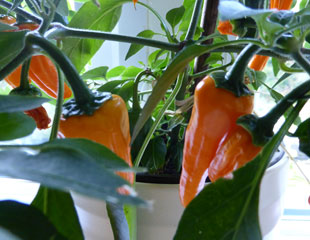

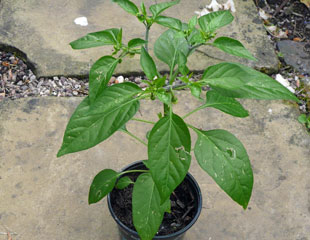
How to grow Chillies
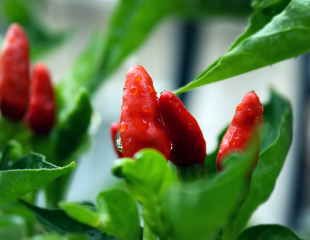
Growing Chillies key Points
Warmth is key to all growing stages.
Minimum temperatures to germinate from seed is at least 25C.
Water sparingly.
Pinch out main stem and early shoots to make the plant bushier.
Grow under glass or indoors unless in a sheltered warm garden.
Chillies are easy to grow. Their primary requirement is warmth, particularly at the early stages, as they originate from the tropics.
Chillies are ideal for growing in containers, but the size of the container matters, see below. You can grow Chillies outside if you have plenty of sun and sheltered warm conditions. In less favourable conditions, which is most of the UK, and at the beginning/end of the growing season, Chillies are best grown under glass. Early in the year it will be too cold in an unheated greenhouse or poly tunnel for seeds or a young plant. They need to be indoors until all risk of frost has passed, and it is warm.
As soon as the plant starts to flower, this is a signal to start weekly feeding. Feed with high in potash such as tomato feed, which is ideal. Also, when the plant comes into flower, pinch out so that the Chilli plant will throw out more shoots, bush and produce a better crop.
If the leaves of the Chilli plant turn yellow, or drop off, the likely cause is over-watering. The general rule is to water Chillies sparingly.
There is a gardening debate about whether you can over winter chilli plants. It is true to say, especially in northern climates, Chillies are best treated as an annual. Even if you persuade the Chilli plant through the winter, the ensuing plant will be less vigorous, if not feeble, and you may not get much by way of fruit.
Equally, for the cost of a chilli plant, you can compost it and buy another each year, or grow from seed. They are still great value cropping from one small chilli plant, maybe 40+ chillies
How to Grow Chillies from Seed
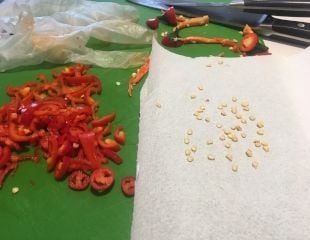
Chillies germinate easily from seed. You can buy from an enormous range of seeds or save seeds from chilli at the end of the season, as illustrated left. Just scrape out the seeds, dry them and keep dry and cool over winter.
To grow Chillies from seed, put one/two seeds into a single pot just below the surface. Sow Chillies shallow and sprinkle with minimal compost or vermiculite. Chillies can take some time to germinate, which if conditions are damp can encourage fungus. If this becomes a problem, cover the Chilli seeds with vermiculite, as opposed to compost.
The pot needs to be misted, and either covered with glass or put into a propagator. Leave to germinate, which should take up to 21 days. To germinate Chillies need a constant temperature of between 20-25 degrees which means germinating somewhere warm with a steady temperature.
It is important to know that Chillies need a long growing season. If you are growing them from seed, you will need to germinate early, and even earlier in the North of England (because of the shorter growing season,) from late January/early February onwards, provided you have somewhere warm (indoors) to keep the plants. Sowing Chilli seeds early in the year, in less than ideal conditions, increases the risk of the seedling being leggy. You can repot and replant the leggy seedling deep to overcome this. Chillies are like tomatoes in this respect. The stem part which you bury will grow roots and make for a tougher plant.
Video: The Sunday Gardener What To Do About Leggy (Chilli) Seedlings
Chillies dislike root disturbance and they are best sown into modules and transferred into a pot with all the root ball and a little soil disturbance .If you are growing on a windowsill, rotate the pot daily to ensure even growth and avoid leggy seedlings.
During the early stages of the growing season, it is often necessary to repot into a larger pot. You can tell when a Chilli is plant is too large for the pot as it looks top heavy (image top right). Another indicator is that when you look underneath at the bottom of the pot, tipping it carefully upside down, you can see the roots fighting to get out and straying out of the pot. Pot on carefully keeping the root ball intact.
How to keep Chillies warm
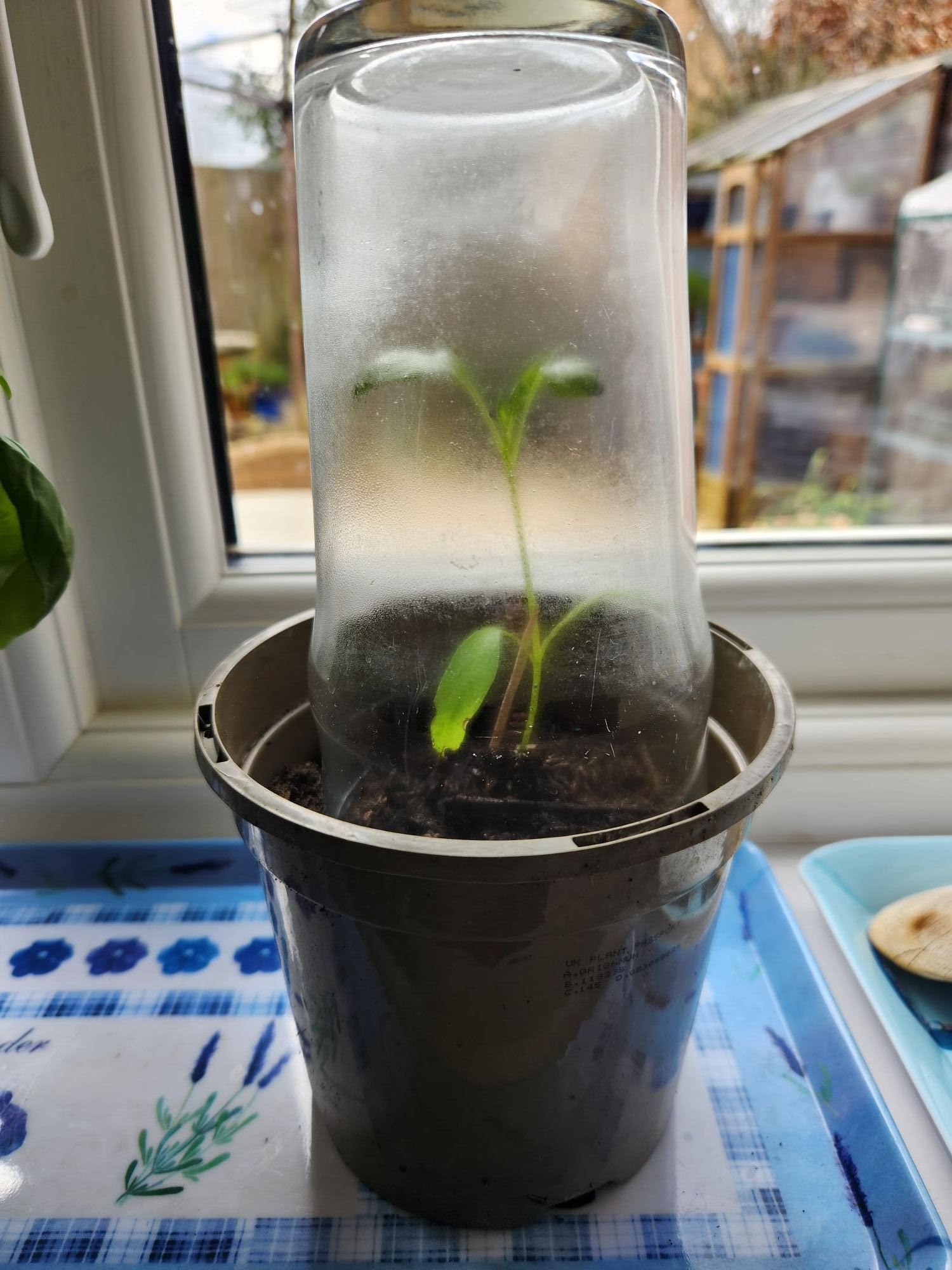
Chillies like to be kept warm, which is not always easy because we have to sow early in the year for a long growing season.
This can often mean germinating and growing on indoor windowsills to keep warm and get the best light. But, windowsills can be chilly spots, especially at night.
One way to cosset your seedling is to make a homemade propagator. It is easy enough to start the germination process using a ploy bag and elastic band, but once the seedling grows, it needs more space.
This is a pint pot glass slipped over the top of the seedling to keep it warmer and to add moisture. Ideal until the seedling gets sturdier and temperatures warm up.
What size pot to grow Chillies in ? Size does matter

This image demonstrates the effect of growing Chillies in different sized pots. And it results in different sized plants.
I planted the chillies in the long brown planter from the containers in front of the respective plants. All seeded and grown together. You will see that the largest plant, left, was grown in the largest container and at the end the smallest plant was repotted from the smaller container.
You cannot put a small chilli plant straight into a large pot, it will not thrive. But you can pot it on into large pots and ensure that the final container, for the rest of the growing season, is a good size if you want a really good plant and crop.
Chillies are self pollinating what does this mean?
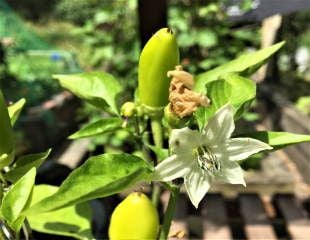
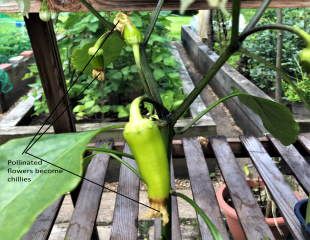
The image left shows the flowers on a young chilli plant and on the right the chillies forming from the spent flower. The good news is that chillies, unlike, say tomatoes, are self pollinating, which means the plant will pollinate itself. This makes chillies easier to grow as there are fewer problems with a lack of pollination or pollinators, which can be a problem in cool summers for outside grown plants, such as courgettes. Another reason chillies are a green wheelbarrow plant.
Best chillies for containers
Most varieties of chilli will grow well in a container provided the growing conditions are correct.
In 2006 The RHS undertook a wide reaching trial of chillies including sweet and spicy chillies. Commonly grown varieties with the AGM include 'Demon Red' which is very hot, 'Hungarian Hot Wax' milder and very easy to grow, and 'Summer Heat' a Jalapeno type. The full list of varieties which have the Award of Garden Merit as a result of the trial, full details on this link.
The RHS also undertook a trial of chillies to determine those most suitable to grow in containers. Suggestions are: 'Riot' a long thin chilli, moderately hot; 'Krakatoa' a thicker cone shaped red chilli hot; 'Spike' a thin, very hot chilli. These are all short compact chillies suitable for container growing in a warm spot bearing in mind chillies are H1 hardy which is 5-10 degrees.
You do not need a garden to grow chillies. They are ideal to grow in containers, on windowsills and balconies. Ideas about suitable vegetables to grow in containers, growing vegetables in containers.
What to do with a glut of Chillies
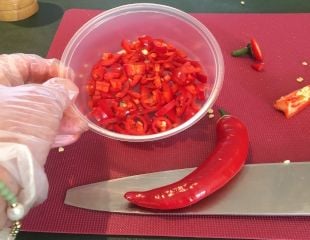
Chillies freeze really well. You can freeze them whole and defrost by rinsing a chilli under the hot tap. Sometimes they can be a bit mushy. This can be avoided by chopping the chillies and then freezing. You will then have a Gardener's Lazy Chilli as per the image on the left. Just take out what you need as and when.
You can also dry them and then crumble into flakes and store in a herb jar for use over the winter. Wash and dry them, slice in half and lay on baking tray. Place in oven on low setting around 80-100C checking regularly. The low setting is essential to stop the chillies charring. It will take several hours. In theory, you can dry them outside, but it rarely gets warm enough to properly dry them. You could also dehydrate them in an air fryer.

Chillies are an easy to grow green wheelbarrow plant
